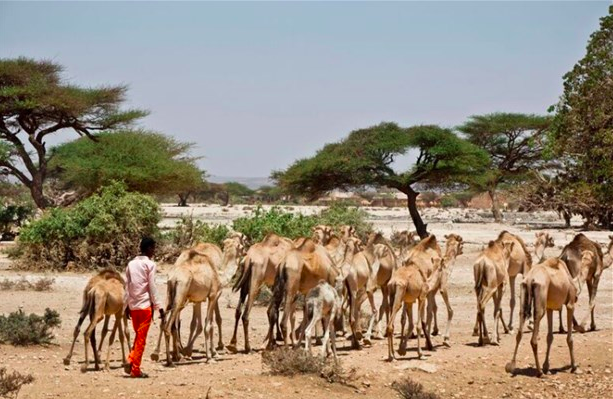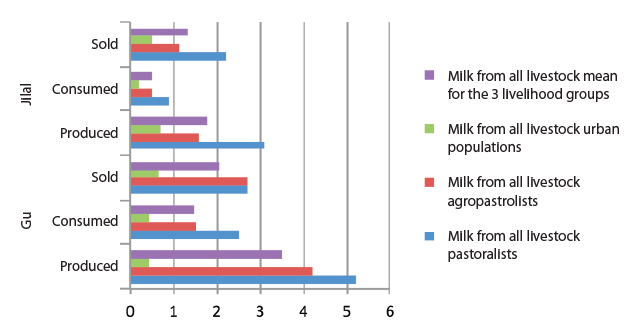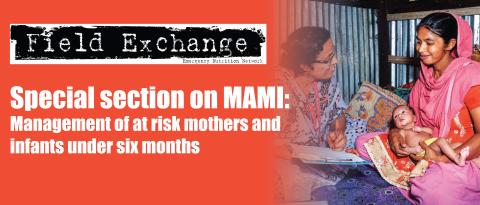Feasibility of a milk matters initiative to enhance milk intake in children over six months of age in Somalia
By Fatmata Fatima Sesay, Dr Binyam Woldetsadik Gebru, Minh Tram Le, Dr Sayed Ezatullah Majeed, Patrick Codjia and Marjorie Volege
Fatmata Fatima Sesay is a nutrition specialist with UNICEF Somalia, providing technical support for infant and young child feeding, micronutrients and resilience programming. She has over ten years’ experience in nutrition and public health programming in both emergency and development contexts with UNICEF and non-governmental organisations.
Dr Binyam Woldetsadik Gebru is the Health and Nutrition for Save the Children Somalia/Somaliland. He previously worked in Nigeria, Rwanda, Somalia and the Democratic Republic of Congo in health and nutrition and leadership. He graduated as a medical doctor from Addis Ababa University and has an MSc in public health from the London School of Hygiene and Tropical Medicine.
Minh Tram Le is a Humanitarian Nutrition Adviser for Save the Children Eastern and Southern Africa Regional Office. She has worked for the past ten years with Save the Children and other organisations in the west Balkans region for European refugees and the migrant crisis, central and south Asia (Pakistan, Afghanistan, India) and West Africa.
Dr Sayed Ezatullah Majeed has worked with UNICEF since 2000 in different capacities in Afghanistan, Democratic People’s Republic of Korea, Sudan, Eritrea and Sri Lanka. Since May 2014 he has been Chief of Nutrition in Somalia. He previously worked for the Ministry of Health Afghanistan and with NGOs in Afghanistan and Pakistan. He is a medical doctor with a Master’s degree in strategic planning and a post-graduate diploma in nutrition.
Patrick Codjia is Chief of Nutrition for UNICEF Kenya. Prior to this he worked for UNICEF Eastern and Southern Africa Regional Office and UNICEF Country Offices in Malawi, Democratic Republic of Congo and Botswana on both development and emergency nutrition programmes and was involved in operational research in Burkina Faso.
Marjorie Volege is the Nutrition Specialist – Emergency for UNICEF, Eastern and Southern Africa (ESARO) regional office, providing technical support to 21 countries on nutrition in emergencies. She has over 12 years’ experience in nutrition in both humanitarian and development contexts in Ethiopia, Kenya, South Sudan with UNICEF and other organisations.
The authors would like to acknowledge the support of UNICEF ESARO, UNICEF Somalia, Save the Children ESARO and Somalia and the HSED Group Kenya in conducting this research.
Location: Somalia
What we know: Pastoralist communities rely heavily on meat and milk for nutrition; seasonal availability varies, which may impact on intake.
What this articles adds: A feasibility study was carried out in Hiran region of Somalia in 2016 to determine the viability of a ‘milk matters’ intervention in pastoral communities to enhance nutritional intake of children aged 6-23 months before and during lean seasons. Key learning areas include: the need to enhance milk production and consumption through maximising production during the lean season, prioritise empowerment of women (as key decision-makers on household consumption and use) and investment in the rearing of goats. Multi-sector engagement is essential, coupled with behaviour change communication. The expected benefits go beyond nutrition to include improved livestock production systems, improved access to income and improved community resilience.
Background
Countries in the Horn of Africa continue to face food security challenges1. Pastoral and agro-pastoral communities relying on subsistence crop farming and livestock rearing as main sources of livelihood are the most affected. The nutrition situation in Somalia is one of the worst in the world, with a global acute malnutrition (GAM) prevalence of over 15%, which rises to 30% in some locations (classified as critical). The causes of malnutrition in Somalia are multiple, including poor infant and young child feeding (IYCF) practices, untreated sickness, food insecurity, poor water and sanitation practices and conflict. A quarter of Somalia’s population is pastoral, with nomadic habits and reliance on meat and milk as major diet components. Dietary diversity is generally poor, reflecting the inadequacy of food access and availability, especially micronutrient-rich foods.
A feasibility study was carried out in Hiran region of Somalia in 20162 to determine the viability of a ‘milk matters’ intervention in pastoral communities aimed at enhancing the nutritional intake of children aged 6-23 months before and during lean seasons. A recent learning paper, summarised in this article, builds on these findings by analysing household patterns in livestock management, milk production, access and utilisation, milk handling, market chain and feeding practices in order to inform the milk matters initiative to maximise impact. The study also provides valuable information on the overall suitability and risks of implementing the project. It is intended to empower nutrition programme implementers in designing priority actions for nutrition-sensitive, resilience-building programmes, as well as defining key areas of investments.

Method
Data were collected between March and August 2016 in three livelihood groups: pastoralists, agro-pastoralists and internally displaced persons (IDPs)/urban populations in Mataban and Beletwyene districts (where there are plans to implement the milk matters initiative in future, subject to the availability of funding). Twenty-eight key informant interviews were carried out with men and women in the communities, including leaders and milk traders. Sixteen focus group discussions were held with community members and 1,534 quantitative surveys were carried out with respondents from 767 households.
Results
Livelihoods and their management: Pastoralists relied on livestock production as their main source of income. One third (32.7%) of pastoralist and all (100%) agro-pastoralist households reported that they had land access; 44% of urban population respondents reported that they had some land, albeit in places far from where they were settled. Of the sampled households, 72.4% had goats, 41.2 % had cows, 44.6% had camels and 23.8% had sheep. Results showed seasonal variability, with greater herd sizes in wet compared to dry seasons (23% difference), and greater availability of fodder in the wet season (60.3%) compared to dry (42.9%). Livestock management was found to be a male responsibility, while decisions on milk use were predominantly made by females in consultation with males, as reported in 75% of the surveyed households. In total, 64.2% of women were responsible for milk handling, storage and transportation to selling points. Pastoralists migrated with their herds (mainly cows and camels) during drought or seasonal stresses, leaving goats behind for milking purposes (75.9%).
Milk consumption: Across all three livelihood groups, consumption of milk is high during the high production season and low during the low production; hence production of milk is the main barrier to milk consumption and utilisation, as reflected in Figure 1. During the wet season (Gu), milk consumption was higher and milk provided a major source of income. Households consumed 41.8% and 27.8% of produced milk in wet and dry (Jilal) seasons respectively. More than half (52.3%) of pastoralists had milk surplus during the wet season, consumed by children under five years in 80% of households. In 71.2% of the households, milk was added to vegetables, potatoes, water or tea before feeding children. In households with no livestock, an average of 0.56 litres was purchased daily in wet seasons, of which 0.38 litres was consumed by children aged 6-59 months (68%), compared to 0.5 litres of milk purchased daily by households with no livestock in the dry season (no significant difference between volume of milk bought between the two seasons (P=0.547). Figure 1 compares patterns of milk utilisation between each of the three groups (pastoralists, agro-pastoralists and urban dwellers) in both regions.
Figure 1: Milk utilisation in the household 24 hours before the survey

Milk availability and management: Low milk availability was perceived to contribute to the poor nutrition status of children in 27.7% of households across the livelihoods. Communities generally perceive the benefits of animal milk in the prevention of malnutrition. Knowledge on optimal breastfeeding and complementary feeding was low (37.7% and 33.1% respectively). In 47.3% of households, milk was boiled for consumption and traditional methods such as cold-water storage (28.6%), repeated boiling (56%), fermentation and mixing with traditional herbs were used to preserve unconsumed milk. Restricted access to markets, insecurity, seasonal floods, limited marketing skills, poor storage facilities and seasonal availability were factors limiting milk markets. Most small-scale traders were women (97.6%). Only 4.9% of the milk traders were engaged in milk production. In Hiran region a lack of companies processing and preserving milk was cited as a problem. Other than fermentation (35.1%), there were no other known milk products in the region, showing a limitation in value addition.
Key learning points
Livelihoods and their management
Results show good acceptability of milk among young children in pastoral and agro-pastoral communities and the use of milk to enhance household revenue; therefore investing in increased milk production and processing capabilities to ensure milk availability beyond the production season has the potential to increase milk consumption among young children and enhance household income. Advocacy is needed to reinforce multi-sector engagement – agriculture, water, sanitation and hygiene, health and nutrition – to enhance milk production and processing. Results show a clear preference for goats among pastoralists for both milk and meat, due to their relative affordability, taste of the meat and tolerance to drought and disease. Domestically, goats are also considered easier to keep at home by women due to their smaller size. Future programmes should therefore focus livestock investments on goats.
Women are the main decision-makers on milk utilisation in households; there is therefore great potential to mobilise women’s groups for the improvement of milk production and enhanced nutrition status among children. While the focus is on women, engagement of the men in the programme is required to provide supportive roles for sustainability. The mobilisation of community groups, including men, for fodder management, water management, rangeland and environment management is essential.
Milk production
The high consumption of milk in Gu is attributed to high milk production in the households, low prices of milk and limited markets due to over-production. Milk production should be maximised during dry seasons and milk preservation should be maximised during wet seasons to support continuity of use. Possible basic interventions could include fodder and water management, support to quality veterinary services, and promotion of appropriate nutrition and IYCF practices. Pilot and scale-up should focus on pastoral and agro-pastoral communities, where incidence of livestock ownership is high and traditional practices recognise the importance of milk in enhancing nutrition among children. Further research is needed to determine the impact of the milk consumption on nutrition status.
Milk consumption by households and children
Milk is perceived to be an important food in the prevention of malnutrition in children and is used to enrich complementary foods for infants. Behaviour change communication (BCC) is needed that focuses on sustained production and milk consumption across the seasons, alongside the promotion of optimal complementary feeding. The availability of milk in the households does not seem to influence breastfeeding patterns among mothers; rather breastfeeding is influenced by socio-cultural practices. The feasibility study did not provide information on milk consumption specifically among children aged 6-23 months and monitoring of milk intake for this category should be considered.
Milk availability and management
The study noted poor hygiene practices in milk handling and preservation. Improving hygiene and safety practices should be prioritised, alongside other water and sanitation-related interventions, such as establishing water catchment dams and underground tanks for water harvesting and developing boreholes at strategic points to boosting milk production. Such interventions will help tackle some of the underlying causes of malnutrition. Investment is also needed in the surveillance of milk availability, including monitoring; analysis of supply, market availability and price could also contribute to enhancing decisions about milk management.
Conclusion
Focusing on milk production and processing during the wet season are effective strategies to address food access and improve child nutrition intake in pastoral and agro-pastoral communities of Somalia. Key boosters to enhance milk production at household level are availability of pasture, land, water, animal breeds and veterinary services (see Box 1). The processing and optimisation of milk product availability beyond production time is also important and outlines the importance of food systems (supply of and demand for milk products) to enhance child nutrition intake and status in agro-pastoral areas, complemented by quality nutrition education on utilisation.
To maximise impact, milk matters interventions should aim to enhance milk production and processing during the wet season and should focus on building the capacity of communities in milk handling, increased production and preservation. Quality BCC strategies related to IYCF should also be implemented in conjunction. The expected benefits go beyond nutrition to include improved livestock production systems, improved access to income and improved community resilience.
Box 1: Proposed interventions
- Water availability
- Land use and fodder production
- Forage conservation/Crop residue management
- Fodder/Livestock health vouchers
- Supplementary feeding of livestock
- Breed improvement
- Balancing the livestock population and available feed resources
- Training of community animal health workers
- Improvements to the livestock and product marketing system through market linkages and infrastructure creation
- Trainings on milk hygiene practices
- Local supply of milk-handling equipment
- Nutrition education with a focus on optimal IYCF practices
For more information, please contact Marjorie Volege.
Endnotes
1East Africa food security Outlook January to June 2018, and July to September 2018 www.fews.net/east-africa


